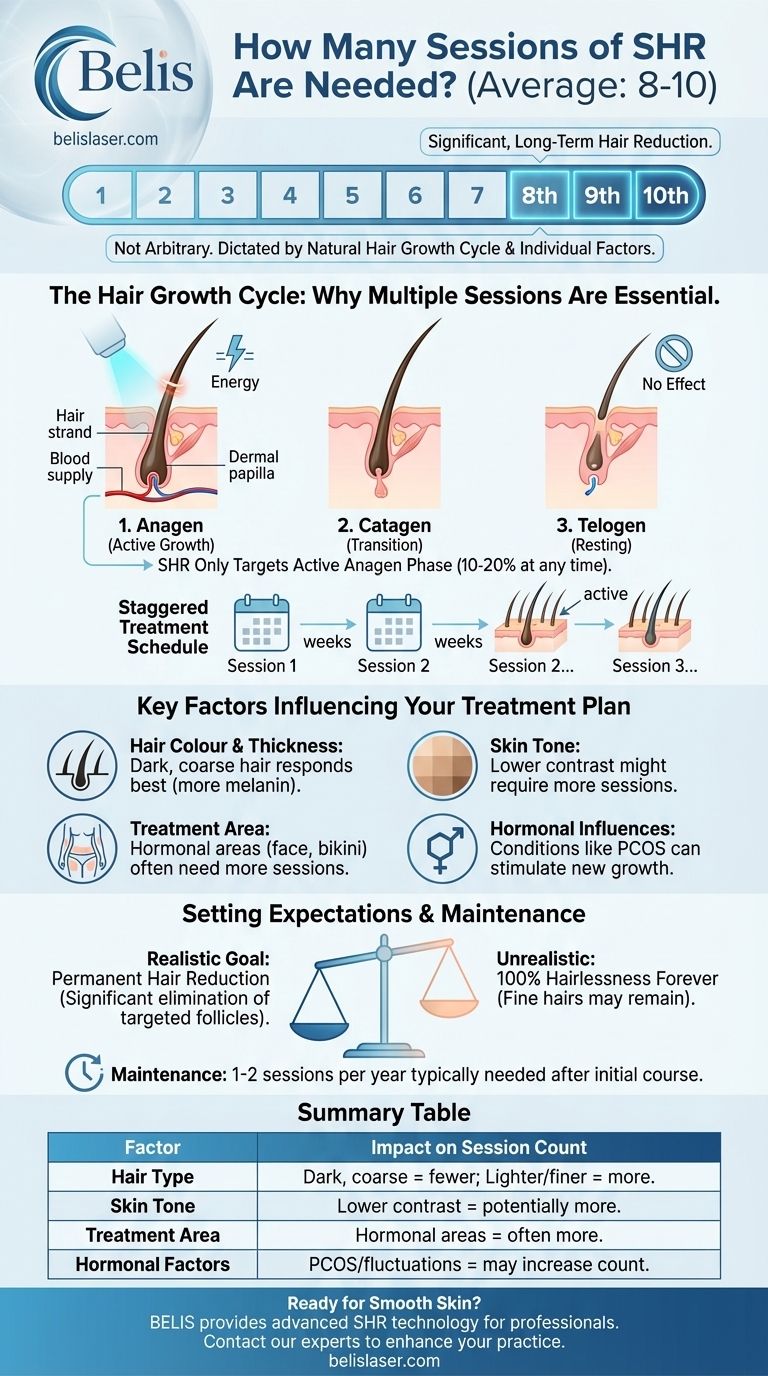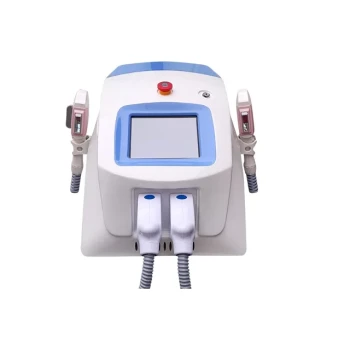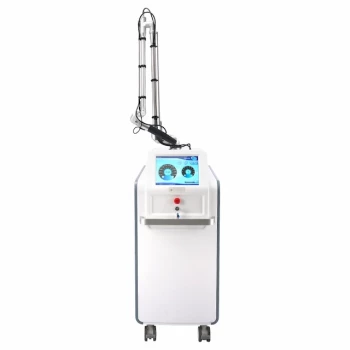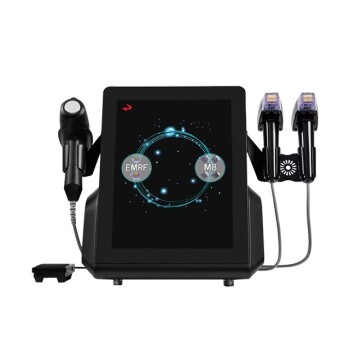On average, you will need between 8 and 10 sessions of Super Hair Removal (SHR) to achieve significant, long-term hair reduction. This number is not arbitrary; it is dictated by the natural growth cycle of your hair and varies based on factors like the treatment area, your hair type, and your skin tone. Each session is typically scheduled several weeks apart to maximize effectiveness.
The core principle to understand is that SHR can only destroy hair follicles that are in their active growth phase. Because your hairs are not all in this phase at the same time, multiple sessions are required to systematically target and treat every follicle as it cycles into this active stage.

Why Multiple SHR Sessions Are Necessary
The need for a series of treatments is rooted in biology, not the technology's limitations. The process is designed to work in sync with the way your hair naturally grows.
The Hair Growth Cycle
Every hair on your body goes through a three-stage cycle: Anagen (active growth), Catagen (transition), and Telogen (resting).
- Anagen Phase: This is the active growth stage where the hair is attached to the dermal papilla (the root), which supplies it with blood.
- Catagen Phase: The hair follicle detaches from the papilla, and the hair stops growing.
- Telogen Phase: This is the resting stage where the old hair sheds, and the follicle prepares to produce a new one.
Targeting Hair in the Active (Anagen) Phase
SHR technology works by gradually heating the dermis to a temperature that effectively damages the hair follicle and prevents regrowth. This energy is absorbed by the melanin in the hair shaft and transferred to the follicle.
Crucially, this process is only effective when the hair is in the anagen phase, as this is the only time it is physically connected to its nourishing blood supply.
Staggered Cycles Mean Staggered Treatments
At any given moment, only about 10-20% of your hair in a specific area is in the anagen phase. The remaining hairs are either resting or transitioning.
Therefore, a single SHR session can only treat the fraction of hair that is currently active. The subsequent sessions are scheduled weeks later to catch the next group of hairs as they enter the anagen phase.
Key Factors That Influence Your Treatment Plan
While 8-10 sessions is a reliable average, your personal treatment plan will be tailored based on a few key variables.
Hair Colour and Thickness
SHR is most effective on hair that is dark and coarse. Darker hair contains more melanin, which acts as the target for the light energy, allowing for more efficient heat transfer to the follicle. Finer or lighter hair may require additional sessions.
Skin Tone
One of SHR's main advantages is that it is significantly safer for darker skin tones than traditional IPL. However, the level of contrast between your skin and hair still plays a role. A lower contrast may require a more conservative energy setting, potentially increasing the total number of sessions needed.
Treatment Area
Different body parts have different hair growth characteristics. Areas not primarily driven by hormones, like the legs or arms, often respond predictably.
Hormonally sensitive areas—such as the upper lip, chin, and bikini line—can have more resilient and dense hair growth, which may demand more than the average number of sessions.
Hormonal Influences
Underlying hormonal conditions, such as Polycystic Ovary Syndrome (PCOS), or natural fluctuations can stimulate the growth of new hair follicles. While SHR can effectively treat the existing hair, it cannot prevent new follicles from being created due to these internal factors.
Understanding the Trade-offs and Setting Expectations
Objectivity is critical when considering any cosmetic treatment. Understanding the limitations and realistic outcomes of SHR is key to your satisfaction.
"Permanent Hair Reduction," Not Removal
The industry standard and regulatory term is "permanent hair reduction." This is a critical distinction. A full course of SHR can eliminate the vast majority of targeted follicles.
However, it is unrealistic to expect 100% hairlessness forever. Some very fine, light hairs may remain, and hormonal changes can trigger new growth over time.
The Importance of Treatment Intervals
Adhering to the recommended schedule is vital for success. Sessions are typically spaced 4-6 weeks apart for the face and 6-8 weeks apart for the body.
Stretching this timeline too far means you will miss the window to treat follicles as they enter the anagen phase, making the overall process less effective and potentially requiring more sessions.
The Role of Maintenance Sessions
Once you complete your initial course of 8-10 sessions, you can expect the area to remain smooth for a long time. Most individuals find they need one or two maintenance sessions per year to target any new hair that has cycled into growth or been activated by hormonal shifts.
Making the Right Choice for Your Goal
Use the following guidelines to set your personal expectations for an SHR treatment plan.
- If your primary focus is a large area with coarse hair (e.g., legs, back): You can confidently expect to fall within the standard 8-10 session range and see excellent, lasting reduction.
- If your primary focus is a hormonal area (e.g., face, bikini line): Be prepared for the possibility of needing more than 10 initial sessions and a greater commitment to annual maintenance.
- If your primary focus is managing budget and expectations: Plan for a full course of treatment and factor in the cost of 1-2 touch-up sessions per year to maintain your results long-term.
Ultimately, achieving long-term smoothness with SHR is a marathon, not a sprint, that rewards a consistent and well-planned approach.
Summary Table:
| Factor | Impact on Session Count |
|---|---|
| Hair Type | Dark, coarse hair responds best; lighter/finer hair may need more sessions. |
| Skin Tone | Lower contrast between skin & hair may require more sessions. |
| Treatment Area | Hormonal areas (face, bikini) often need more sessions than legs/arms. |
| Hormonal Factors | Conditions like PCOS may increase the number of sessions needed. |
Ready to Start Your Journey to Smooth, Hair-Free Skin?
Achieving lasting hair reduction requires a precise treatment plan tailored to your unique hair and skin. BELIS specializes in professional medical aesthetic equipment, providing clinics and premium beauty salons with the advanced SHR technology needed for effective, safe, and comfortable treatments.
Let us help you deliver exceptional results to your clients. Our expertise ensures you have the right equipment to create personalized treatment plans that maximize efficiency and patient satisfaction.
Contact our experts today to learn how BELIS can enhance your practice's offerings and support your business growth.
Visual Guide

Related Products
- Clinic Diode Laser Hair Removal Machine with SHR and Trilaser Technology
- Diode Tri Laser Hair Removal Machine for Clinic Use
- Diode Laser SHR Trilaser Hair Removal Machine for Clinic Use
- Trilaser Diode Hair Removal Machine for Beauty Clinic Use
- Clinic Use IPL and SHR Hair Removal Machine with Nd Yag Laser Tattoo Removal
People Also Ask
- What is the No 1 laser hair removal machine? Find the Best Device for Your Skin & Hair
- How does diode laser hair removal work? The Science of Targeting Hair Follicles
- How long does diode hair removal last? Achieve Long-Term Smoothness
- Can you use laser hair removal on intimate areas? Achieve Lasting Smoothness and Comfort
- Which is safer, diode or IPL? Discover the Safer Choice for Hair Removal



















